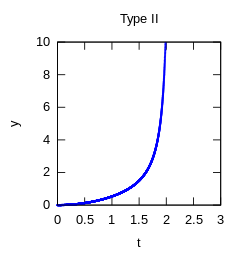
A | B | C | D | E | F | G | H | CH | I | J | K | L | M | N | O | P | Q | R | S | T | U | V | W | X | Y | Z | 0 | 1 | 2 | 3 | 4 | 5 | 6 | 7 | 8 | 9
In mathematics, Painlevé transcendents are solutions to certain nonlinear second-order ordinary differential equations in the complex plane with the Painlevé property (the only movable singularities are poles), but which are not generally solvable in terms of elementary functions. They were discovered by Émile Picard (1889), Paul Painlevé (1900, 1902), Richard Fuchs (1905), and Bertrand Gambier (1910).
History
Painlevé transcendents have their origin in the study of special functions, which often arise as solutions of differential equations, as well as in the study of isomonodromic deformations of linear differential equations. One of the most useful classes of special functions are the elliptic functions. They are defined by second-order ordinary differential equations whose singularities have the Painlevé property: the only movable singularities are poles. This property is rare in nonlinear equations. Poincaré and L. Fuchs showed that any first order equation with the Painlevé property can be transformed into the Weierstrass elliptic equation or the Riccati equation, which can all be solved explicitly in terms of integration and previously known special functions.[1] Émile Picard pointed out that for orders greater than 1, movable essential singularities can occur, and found a special case of what was later called Painleve VI equation (see below). (For orders greater than 2 the solutions can have moving natural boundaries.) Around 1900, Paul Painlevé studied second-order differential equations with no movable singularities. He found that up to certain transformations, every such equation of the form
(with a rational function) can be put into one of fifty canonical forms (listed in (Ince 1956)). Painlevé (1900, 1902) found that forty-four of the fifty equations are reducible in the sense that they can be solved in terms of previously known functions, leaving just six equations requiring the introduction of new special functions to solve them. There were some computational errors, and as a result he missed three of the equations, including the general form of Painleve VI. The errors were fixed and classification completed by Painlevé's student Bertrand Gambier. Independently of Painlevé and Gambier, equation Painleve VI was found by Richard Fuchs from completely different considerations: he studied isomonodromic deformations of linear differential equations with regular singularities. It was a controversial open problem for many years to show that these six equations really were irreducible for generic values of the parameters (they are sometimes reducible for special parameter values; see below), but this was finally proved by Nishioka (1988) and Hiroshi Umemura (1989). These six second order nonlinear differential equations are called the Painlevé equations and their solutions are called the Painlevé transcendents.
The most general form of the sixth equation was missed by Painlevé, but was discovered in 1905 by Richard Fuchs (son of Lazarus Fuchs), as the differential equation satisfied by the singularity of a second order Fuchsian equation with 4 regular singular points on the projective line under monodromy-preserving deformations. It was added to Painlevé's list by Gambier (1910).
Chazy (1910, 1911) tried to extend Painlevé's work to higher-order equations, finding some third-order equations with the Painlevé property.
List of Painlevé equations
These six equations, traditionally called Painlevé I–VI, are as follows:
- I (Painlevé):
- II (Painlevé):
- III (Painlevé):
- IV (Gambier):
- V (Gambier):
- VI (R. Fuchs):
Antropológia
Aplikované vedy
Bibliometria
Dejiny vedy
Encyklopédie
Filozofia vedy
Forenzné vedy
Humanitné vedy
Knižničná veda
Kryogenika
Kryptológia
Kulturológia
Literárna veda
Medzidisciplinárne oblasti
Metódy kvantitatívnej analýzy
Metavedy
Metodika
Text je dostupný za podmienok Creative
Commons Attribution/Share-Alike License 3.0 Unported; prípadne za ďalších
podmienok.
Podrobnejšie informácie nájdete na stránke Podmienky
použitia.
www.astronomia.sk | www.biologia.sk | www.botanika.sk | www.dejiny.sk | www.economy.sk | www.elektrotechnika.sk | www.estetika.sk | www.farmakologia.sk | www.filozofia.sk | Fyzika | www.futurologia.sk | www.genetika.sk | www.chemia.sk | www.lingvistika.sk | www.politologia.sk | www.psychologia.sk | www.sexuologia.sk | www.sociologia.sk | www.veda.sk I www.zoologia.sk











